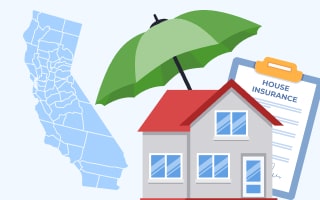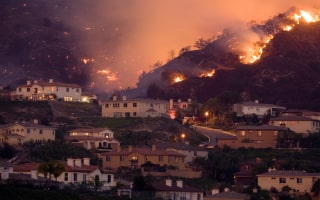Homeowners Insurance in California

No one likes paying monthly premiums, but California homeowners insurance is something you'll be glad you have when you need it. Although the Golden State offers residents many wonderful things, it is also known for frequent natural disasters like earthquakes, wildfires, floods, volcanic eruptions, tsunamis, landslides, and hurricanes. Since 1953, California has had 284 federally declared disasters (the most of any state in the U.S.), and the rate of disasters per 1 million people is 7.3.
Along with numerous claims for damage caused by natural disasters, California homeowners also file claims for water damage caused by faulty plumbing, other types of property damage, dog bites, theft, fire, and liability/bodily injury.
Homeowners insurance in California is a crucial resource protecting your home from various threats. Although the state doesn't legally require it, most lenders will. If you borrow money to purchase a home, your bank will demand that you carry specific homeowners insurance limits on the house until you pay off the loan.
As of October 2024, the average rate for homeowners insurance across the U.S. is $2,728 per year or $227 monthly. California residents pay an average of $1,422 annually, about half the national average.
Types of Homeowner Insurance Coverage Available in California
Insurance providers decide which states to operate in and what types of coverage to offer. In California, you can purchase various types of homeowner coverage for your property. The most common types include:
-
Dwelling: Coverage A provides repair or replacement coverage to your main home and other attached structures in case of catastrophic damage due to the covered perils.
-
Other Structures: Coverage B protects other buildings on the property, like barns, garages, and sheds. This coverage is usually limited to 10% of the coverage A limit.
-
Personal Property: Coverage C protects the contents of your home and personal property. It is usually limited to 50% of the coverage A limit. Some items like furs, jewelry, antiques, firearms, collectibles, and silverware may be limited further.
-
Loss of Use: If your home is damaged and unlivable, coverage D will provide you with money to cover the extra living expenses until you can return to your home. They typically cover housing, meals, storage, and other items like that.
-
Personal Liability: Coverage E will pay for damages and legal and insurance costs if you injure someone else. This coverage may have limitations, especially if you intentionally hurt someone.
-
Medical Payments to Others: If someone is accidentally hurt while on your property, this coverage will pay for their medical bills.
Since most of California is situated on the coast, flood insurance is also a good idea. Also, consider an umbrella policy to fill any gaps in your coverage. Those needing more than $500,000 in coverage should consider an umbrella policy. Carriers can typically go up to $5 million in liability protection.
FEMA (Federal Emergency Management Agency) manages the National Flood Insurance Program (NFIP) through a network of 50 providers across the U.S.
Since most homeowners insurance does not cover floods, this supplemental coverage can repair damage and replace items after a flood. It can cover the building and/or your personal belongings, depending on your options. This program is available to homeowners, renters, and businesses. Learn more about the program on FEMA's website.
Obtaining coverage for things like fires, floods, and earthquakes is more difficult. However, if you are willing to pay higher premiums, you can sometimes get this coverage through special insurance companies like the National Flood Insurance Program (NFIP) and the California Fair Plan Property Insurance. If you plan to live in California, research your options for coverage of hurricanes, floods, fires, and natural disasters.
Home Insurance and Natural Disasters
Climate change affects every U.S. state, hitting insurance providers hard with abundant claims and catastrophic losses. Some states have it worse than others. Frequent severe weather events are driving home insurance rates through the roof. Across the country, rates have risen by 34% and as high as 60% in some locations. In California, homeowners insurance rates have increased by a whopping 43.7%!
California is prone to many different types of natural disasters, such as earthquakes, wildfires, floods, volcanic eruptions, tsunamis, landslides, and hurricanes. A single wildfire claim costs insurers $77,340. Damage due to wind and hail costs an average of $11,695, and water damage costs an average of $11,650 per claim. From 2015 to 2019, California tops the list of insurance losses totaling $10,733,309,200. California also makes the list of states with the most lightning claims and insurance losses due to lightning for 2021, totaling $522,600,000. Fifteen percent (2,040,600 properties) of homes in California are at risk of wildfires. California also tops the list of states with the most dog bites (2,026) for 2021, with an average cost per claim of $59,561. From 1980 to 2024, California had 46 billion-dollar disasters.
How Can I Save on Homeowner Insurance Premiums in California?
California home insurance premiums are on the rise, making it essential to do all you can to save money. The key is learning what factors contribute to the cost and adjusting from there.
-
Location: Where you live affects your rates more than any other factor. If you live in an area prone to disastrous weather, you will pay more than if you live in a quiet, safe location with very few perils.
-
Age, Size, and Condition: Your home's age, size, and condition also matter. The larger the house, the more it will cost to rebuild it. Older homes, as well as poorly maintained homes, are more expensive to insure.
-
Your Deductible: The higher your deductible, the lower your premiums.
-
Claims History: Your rates will be lower if you have a clean claims history. The more claims you have, the higher the risk, and your rates will increase.
-
Level of Coverage: The more coverage you have, the higher your rates.
-
Cost of Materials & Labor: As the costs of materials and labor increase, so will your insurance rates.
-
Your Credit Score: If you have good credit, you will pay less than someone with poor credit.
-
Risk Factor: If you have "attractive nuisances" like pools, hot tubs, or a trampoline, your risk factor will be higher, and so will your rates.
Some ways to save on California homeowners insurance include:
- Raise Your Deductible: Raise your deductible as high as possible to lower your rates.
- Improve Your Credit: Boost your credit and then ask your insurance agent to re-evaluate your rates.
- Eliminate Risks: Eliminate as many risks as possible to lower your home insurance rates.
- Bundle Policies: Bundle your home and auto policies, and your carrier will usually give you better rates.
- Don't File Small Claims: Hold off on filing small claims; wait for the big stuff to keep your rates low.
- Shop Around: When looking for a provider, shop around. Ask for recommendations and balance quality with price.
- Make Your Home Disaster-Resistant: Improve your roof, siding, and windows to make your home more weather-resistant and lower your rates as a bonus.
- Ask for Discounts: Ask your insurance agent about any discounts they offer.
- Remain Loyal: Stay with the same insurance provider for many years, and they may reward you with lower rates.
- Improve Home Security: Install a home security system to keep your home safer and lower your insurance premiums.
Home Insurance Discounts in California
California homeowners insurance is a policy that covers damage, destruction, and theft of your home and personal belongings. Homeowners insurance is typically customizable, and you can choose specific coverage, but each policy will contain the same general components of dwelling, other structures, liability, medical payments, and loss of use. Some covered perils include fire, smoke, lightning, windstorms, aircraft and vehicle damage, hail, vandalism, theft, snow, ice, volcanic eruptions, and fallen objects (tree limbs).
You can get a home insurance policy quickly in a few different ways. First, you can call the company's 800 number or apply online through their website. You can also contact a local insurance agent and have them help you pick coverages and sign up. Once you decide, you must pay the first year in advance, and then you can pay annually or through your mortgage escrow payments monthly.
The most common discounts you will find with many reputable insurance carriers are:
- Senior Citizen Discount: Many firms give seniors or retirees a special discount when they reach a certain age.
- Loyalty Discount: If you stay with the same company year after year, they may offer you a discount as time passes.
- Bundle Discount: Bundle multiple policies and earn a discount on your rates.
- Military Discount: Most firms offer discounts on home insurance to members of the military or veterans.
- Occupational Discount: Some professions, like firefighters and teachers, earn discounts.
- Non-smoker Discount: Non-smokers offer less fire risk, and insurers discount them.
- Autopay Discount: Your carrier should offer discounts if you sign up for auto payments.
- Paperless Discount: Going paperless is good for the environment and your rates.
- Quote In Advance Discount: Get a quote well before you need it, and you might get a discount.
- Security Discount: Install a security system to avoid theft and vandalism, and your insurance provider will give you a discount.
- Fire-Safety Discount: Install fire safety equipment like sprinklers, smoke alarms, and fire extinguishers for a discount.
- New Home Discount: New homes cost less, and sometimes, you get a big discount.
- Green Discount: Install eco-friendly materials in your home for a discount.
Common Rates Offer by Homeowners Insurance Firms
New construction homes cost far less to insure than older homes. They are built with code-compliant fire-resistant materials, making rebuilding easier after an event. You can spend up to 40% less on a new home and 26% less on a five-year-old or younger house. The average cost of homeowners insurance in California for a new home is $2,003, but your actual price will vary based on your homeowner profile, insurance firm, etc.
Top 10 Home Insurance Firms in California and Average New Home Savings
| Company | % savings |
|---|---|
| Nationwide | 76% |
| USAA | 54% |
| Chubb | N/A |
| Travelers | 63% |
| State Farm Insurance | 51% |
| Amica Mutual Insurance | N/A |
| CSAA Insurance Group | 58% |
| Liberty Mutual | N/A |
| Allstate | 47% |
| Farmers Insurance | N/A |
Home Insurance and Renovations in California

Renovating your home can dramatically increase your value and profit when you sell. But if something happens and you improve the home without updating your insurance policy, you may be unable to rebuild to the same standards. Some updates increase your value and rates. Others increase or decrease risk along with your rates.
![]() Home Renovations that Increase Rates
Home Renovations that Increase Rates
Some home renovations that increase your rates include:
- Building an Addition: When you build on an addition for whatever reason, you add space and value. More space and value means higher premiums on your home insurance.
- Luxury Upgrades: Adding granite countertops, high-end appliances, and expensive lights and faucets can do wonders for your kitchen, but it also makes the home more expensive to rebuild, and therefore, your rates will go up.
- Getting a Trampoline: Trampolines are considered attractive nuisances that add a lot of risk, and insurers charge more when these are on-site.
![]() Home Renovations that Decrease Rates
Home Renovations that Decrease Rates
Some home renovations that decrease your rates include:
- Upgrade Wiring: Old wiring can lead to a fire. Replacing your wiring is not only smart but also helps you save on your home insurance.
- Auto Water Shut-Off Devices: Install auto shut-off devices that stop water leaks and damage. Water alarms also help and could shave money off your rates.
- New Roof/Shatterproof Windows: A new roof helps your house weather storms better. Shatterproof windows, especially in Mississippi, could save you money on your insurance.
Your homeowners insurance does not cover upgrades you make by choice. Your policy will only pay to rebuild or repair your home after a covered peril. Other things that are not covered are pest infestations, rodent damage, and animal damage.
Be sure to update your coverage after any significant renovations. You might also consider a short builder's risk insurance policy, which covers you during the renovation process. Also, speak with your insurance agent; they can inform you of how the renovations will impact your coverage and rates.
California Renters' Insurance

Renters also need homeowners insurance to protect their homes. It does not include any dwelling coverage. The property owner must cover that. The primary purpose of renters insurance is to protect and replace your personal property after a qualifying event. Renters can also benefit from ALE insurance if they are unexpectedly displaced. Renters' insurance policies typically include liability, medical payments, and loss of use. Each policy has limits, and nothing beyond those limits (like expensive jewelry and collectibles) will not be covered.
Some covered perils include:
-
Smoke
-
Fire
-
Windstorms
-
Hail
-
Theft
-
Vandalism
Some of the items that renters insurance covers are:
-
Small Appliances
-
Furniture
-
Clothing
-
Bedding
-
Bath Items
-
Electronics
-
Sporting Equipment
Renters insurance is priced according to three main factors, and they are:
-
Location: Even as a renter, your location matters. If you live in the city, you will pay more than if you live in the country. If your area has many weather events, you will pay higher rates.
-
Coverage Amount: The more coverage you buy, the higher your premiums.
-
Number of Units: The more units in your building, the lower your rates.
California renters typically pay between $147 and $191 a year or $12.21-$16.18 per month for renters insurance.
Condo Insurance in California

California condo owners also need financial protection for their homes. However, it is different than regular homeowners insurance. Condo associations have a master policy that covers the dwelling and will replace the building back to its original condition (when first built) after a disaster. Condo owners will have a policy covering all interior fixtures, personal belongings, etc. The master policy is a shared responsibility policy, paid through monthly condo fees. The purpose of condo insurance (HO-6) is to restore the interior of the condo back to its most current condition. Condo insurance also includes personal property, liability, medical payments, loss of use, and loss assessment coverage.
The difference between condo and renters insurance is that renters insurance has no dwelling coverage, while condo insurance does, but it is limited to the interior only. Plus, the liability portion only applies to people who are injured inside the condo, not on common grounds.
Some things covered by condo insurance include:
- Appliances
- Interior Walls
- Flooring
- Wiring
- Plumbing
- Cabinets
- Countertops
- Furniture
- Light Fixtures
- All Personal Belongings
An average condo owner in California will pay roughly $710/year or $59/month for insurance. The national average is $625 for $60,000 of personal property coverage, $300,000 of liability, and a $1,000 deductible.
Some ways to save money on your condo insurance in California are:
- Raise Your Deductible
- Improve Your Credit
- Change Your Coverage
- Shop Around for Rates
- Opt-in for Paperless Statements and Autopay
- Bundle Your Home and Auto Policies
- Ask for Discounts
- Improve Your Home
- Avoid Small Claims
- Reduce Risks
California Home Insurance Market
The California home insurance market is highly competitive, with many great carriers to choose from. Big companies usually have local insurance agents who work with them. You can typically get better, faster service by working with a local agent. As the entire homeowners insurance industry suffers, California insurers have seen declining profits over the past five years. This is due to losses caused by some devastating wildfires in 2017 and 2018. Providers may pull out of the state, limit coverage, or cancel problematic customers if this continues.
California offers a cornucopia of disastrous weather, including earthquakes, wildfires, floods, volcanic eruptions, tsunamis, landslides, and hurricanes. As this trend continues, residents may find it harder and harder to find the coverage they need.
No federal agency regulates the home insurance industry; that is left up to the states. Each state appoints its own department to monitor providers and rates, investigate complaints, and sanction the guilty. In California, that government agency is the Department of Insurance, located at 300 Capitol Mall, Suite 1500, Sacramento, CA 95814.
Homeowners Insurance Guide
- Homeowners Insurance in California
- Types of Homeowner Insurance Coverage Available in California
- Home Insurance and Natural Disasters
- How Can I Save on Homeowner Insurance Premiums in California?
- Home Insurance Discounts in California
- Home Insurance and Renovations in California
- California Renters' Insurance
- Condo Insurance in California
- California Home Insurance Market
Instant Access to California Property Records
- Owner(s)
- Deed Records
- Loans & Liens
- Values
- Taxes
- Building Permits
- Purchase History
- Property Details
- And More!
Instant Access to California Property Records
- Owner(s)
- Deed Records
- Loans & Liens
- Values
- Taxes
- Building Permits
- Purchase History
- Property Details
- And More!
Homeowners Insurance Guide
- Homeowners Insurance in California
- Types of Homeowner Insurance Coverage Available in California
- Home Insurance and Natural Disasters
- How Can I Save on Homeowner Insurance Premiums in California?
- Home Insurance Discounts in California
- Home Insurance and Renovations in California
- California Renters' Insurance
- Condo Insurance in California
- California Home Insurance Market